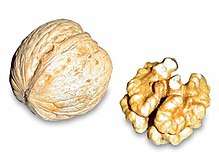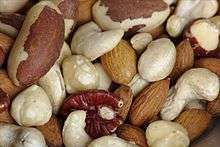Nut (food)
In cuisine, dry nuts are dry, edible fruits or seeds that usually, but not always, have a high fat content.


A nut in cuisine is a much less restrictive and older meaning of the word than the narrow meaning of nut in botany; the term is applied to many seeds that are not botanically nuts. Any large, oily kernels found within a shell and used in food are commonly called nuts. They are often used in making nut butters, a paste of the nuts and oil.
Nuts are an important source of nutrients for both humans and wildlife.[1] Because nuts generally have a high oil content, they are a highly prized food and energy source. Many seeds are edible by humans and used in cooking, eaten raw, sprouted, or roasted as a snack food, or pressed for oil that is used in cookery and cosmetics.[1]
Nuts used for food, whether true nut or not, are among the most common food allergens.[1][2]

Some fruits and seeds that do not meet the botanical definition but are nuts in the culinary sense are:[1]
- Almonds are the edible seeds of drupe fruits – the leathery "flesh" is removed at harvest.
- Brazil nut is the seed from a capsule.
- Candlenut (used for oil) is a seed.
- Cashew is the seed[3] of a drupe fruit with an accessory fruit.
- Chilean hazelnut or Gevuina.
- Macadamia is a creamy white kernel of a follicle type fruit.
- Malabar chestnut.
- Mongongo nut.
- Peanut is a seed and from a legume type fruit (of the family Fabaceae).
- Pecan is the seed of a drupe fruit.
- Pili nut is the seed of the tropical tree Canarium ovatum which grows in the Philippines, Indonesia and Papua New Guinea.
- Pine nut is the seed of several species of pine (coniferous trees).
- Pistachio is the partly dehiscent seed of a thin-shelled drupe.
- Walnut (Juglans) is the seed of a drupe fruit.
- Yeheb nut is the seed of a desert bush, Cordeauxia edulis.
Production
| Nut | Production |
|---|---|
| Coconuts | 61,708,358 |
| Peanuts | 36,456,791 |
| Cashew nuts | 3,350,929 |
| Almonds | 2,361,676 |
| Walnuts | 2,282,264 |
| Chestnuts | 1,408,329 |
| Betel nuts | 1,033,691 |
| Hazelnuts | 765,666 |
| Pistachios | 633,582 |
| Kola nuts | 190,431 |
| Brazil nuts | 77,088 |
| Other nuts | 830,022 |
Currently roughly a dozen nuts are responsible for the bulk of worldwide nut production. The major nut-producing countries for each of the major commercial nuts are:[6]
- Almond: Afghanistan, Australia, Chile, Greece, Iran, Israel, Italy, Morocco, Portugal, Spain, Tunisia, Turkey, United States
- Cashew: Brazil, China, India, Indonesia, Guinea-Bissau, Kenya, Mozambique, Nigeria, Tanzania, Thailand, Vietnam, United States
- Chestnut: China, Turkey, France, Greece, Hungary, Japan, Korea, Portugal, Spain and, more recently, Australia, Chile, New Zealand, United States
- Coconut: Brazil, India, Indonesia, Philippines, Sri Lanka, United States[4]
- Hazelnut: France, Greece, Iran, Italy, Russia, Spain, Turkey, United States
- Macadamia: Australia, Brazil, Costa Rica, Guatemala, Israel, Malawi, South Africa, Thailand, United States[note 3]
- Peanut: Argentina, China, India, Indonesia, Myanmar, Nigeria, Senegal, Sudan, United States, Vietnam
- Pecan: Australia, Israel, Mexico, South Africa, United States
- Pine nut: China, Italy, Lebanon, Portugal, Spain, Turkey, United States
- Pistachio: China, Greece[7], Iran, Syria, Turkey, United States
- Walnut: Argentina, Chile, China, France, Greece, Hungary, India, Iran, Italy, Moldova, North Korea, Turkey, Ukraine, United States, Poland
International trade in exported edible nuts is substantial. In 2004, for example, exports amounted to $5.2 billion, with 56% of these exports coming from developing countries.[8]
Nutrition
Constituents
Nuts are the source of energy and nutrients for the new plant. They contain a relatively large quantity of calories, essential unsaturated and monounsaturated fats including linoleic acid and linolenic acid, vitamins, and essential amino acids.[1] Many nuts are good sources of vitamin E, vitamin B2, folate, fiber, and essential minerals, such as magnesium, phosphorus, potassium, copper, and selenium.[1][9]
This table lists the percentage of various nutrients in four unroasted seeds.
| Name | Protein | Total fat | Saturated fat | Polyunsaturated fat | Monounsaturated fat | Carbohydrate |
|---|---|---|---|---|---|---|
| Almonds | 21.26 | 50.64 | 3.881 | 12.214 | 32.155 | 28.1 |
| Walnuts | 15.23 | 65.21 | 6.126 | 47.174 | 8.933 | 19.56 |
| Peanuts | 23.68 | 49.66 | 6.893 | 15.694 | 24.64 | 26.66 |
| Pistachio | 20.61 | 44.44 | 5.44 | 13.455 | 23.319 | 34.95 |
Research
Nuts are under preliminary research to assess whether their consumption may lower risk for some diseases, such as cardiovascular diseases and cancer.[1][10] A 2014 review indicated that consuming one or more servings of nuts or peanut butter per day could lower the risk of ischemic heart disease, overall cardiovascular disease, stroke in women, and all-cause mortality.[11]
See also
- List of culinary nuts

Notes
References
| Wikimedia Commons has media related to Nuts as food. |
- "Nuts". Micronutrient Information Center, Linus Pauling Institute, Oregon State University, Corvallis, OR. 1 September 2018. Retrieved 28 March 2019.
- "Common Food Allergens". Food Allergy & Anaphylaxis Network. Archived from the original on 2007-06-13. Retrieved 2007-06-24.
- Lina Sequeira. Certificate Biology 3. East African Publishers. pp. 130–. ISBN 978-9966-25-331-6. Retrieved 29 July 2010.
- "FAOSTAT". Food and Agriculture Organization of the United Nations (FAO). Retrieved 2011-11-27.
- Wisner, Robert (January 16, 2012). "Soybean Oil and Biodiesel Usage Projections & Balance Sheet" (PDF). Agricultural Marketing Resource Center. Retrieved 2012-02-19.
- Wilkinson, Jennifer (2005). Nut Grower's Guide: The Complete Handbook for Producers and Hobbyists. Csiro Publishing. p. 14. ISBN 0-643-06963-1.
- Aegina's Pistachios Condé Nast
- Malhotra, S. P. (2008). World edible nuts economy. Concept Publishing Company. p. 9. ISBN 978-81-8069-561-2.
- Kris-Etherton PM, Yu-Poth S, Sabaté J, Ratcliffe HE, Zhao G, Etherton TD (1999). "Nuts and their bioactive constituents: effects on serum lipids and other factors that affect disease risk". Am J Clin Nutr. 70 (3 Suppl): 504S–511S. doi:10.1093/ajcn/70.3.504s. PMID 10479223.
- Aune, D; Keum, N; Giovannucci, E; Fadnes, LT; Boffetta, P; Greenwood, DC; Tonstad, S; Vatten, LJ; Riboli, E; Norat, T (5 December 2016). "Nut consumption and risk of cardiovascular disease, total cancer, all-cause and cause-specific mortality: a systematic review and dose-response meta-analysis of prospective studies". BMC Medicine. 14 (1): 207. doi:10.1186/s12916-016-0730-3. PMC 5137221. PMID 27916000.
- Luo, C; Zhang, Y; Ding, Y; Shan, Z; Chen, S; Yu, M; Hu, FB; Liu, L (July 2014). "Nut consumption and risk of type 2 diabetes, cardiovascular disease, and all-cause mortality: a systematic review and meta-analysis". American Journal of Clinical Nutrition. 100 (1): 256–69. doi:10.3945/ajcn.113.076109. PMID 24847854.